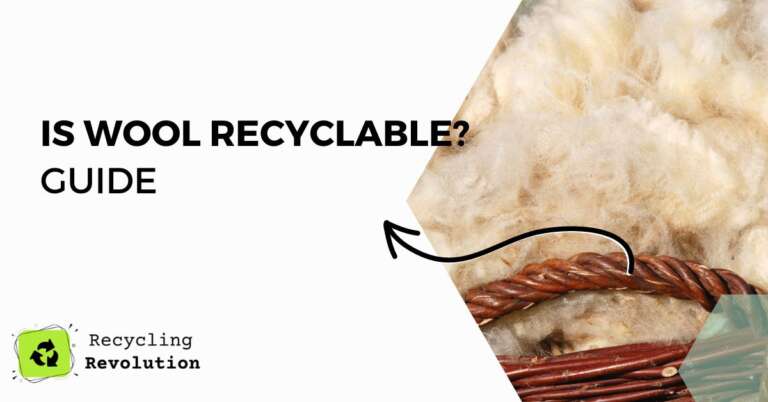Wool is a natural fiber that comes from sheep. It is then cleaned and processed into yarn. Studies show that woolen items can stay for years without having issues. Since wool is natural, is it recyclable? Hence, this article covers everything worth knowing. Read on!
Is Wool Recyclable?
Yes, wool is recyclable. It is a renewable resource and natural fiber that can be broken down and reformed into new wool products or used for other purposes like insulation or stuffing for toys.
Wool is a durable material that is recyclable many times. Thus, it is a popular material for clothing, blankets, carpets, upholstery, and other textiles.
Methods Of Recycling Wool
The recycling of wool is a process that dates back centuries. The methods to do it, namely:
1. Open-loop System: The open-loop system is a simple and effective way to recycle woolen items. This system does not require any special equipment or chemicals. Using simple tools, you can also apply them at home.
In an open-loop system of wool recycling, the wool is collected and transported to a central processing facility where it is cleaned and sorted into different grades. After that, it goes to companies that use it to make new products, such as clothing and insulation.
This system is less expensive than others, and the wool can still go into production, while the downside is that it creates waste, and the quality may be lower than recycled wool in a closed-loop system.
2. The Closed loop System: This is a mechanical process by which woolen garments and other materials made from wool is collected and reused to create new woolen products. This system keeps woolen materials in use and out of landfills and reduces the need for new wool production.
The closed-loop system begins with a collection of used woolen garments and other woolen materials. These materials are then cleaned and processed to remove any impurities. Then, the wool is spun into new yarn to create new woolen products.
It provides many environmental and economic benefits and reduces the need for new wool production, which can save resources and help to preserve natural ecosystems. It also helps keep woolen materials in use, which reduces waste and helps to save money.
3. Re-engineering: Re-engineering has been a long process, but it has been successful. The main aim of this process was to improve the quality of the recycled wool and to make it more durable. For instance, using old wool cardigans to produce bags or using recyclables to create new products.
In addition, recycled wool has much higher quality than before and is much more durable. This has made a big difference in the quality of the wool industry.
The Benefits Of Recycling Wool
Many benefits make the wool recycling process an important one.
1. Reduces Pollution: Recycling wool reduces pollution in several ways. First, it reduces the amount of methane gas released into the atmosphere. Methane is a greenhouse gas that is 25 times more potent than carbon dioxide. So, recycling wool helps reduce the amount of methane gas.
In addition, recycling wool helps to reduce the amount of water used in the wool production process. It takes a lot of water to produce wool; about 55 gallons of water is needed to get one pound of wool. So, recycling decreases the amount of water in the wool production process.
Finally, recycling wool helps reduce the number of pesticides and chemicals used in the wool production process. Wool is often treated with pesticides and chemicals to keep it from being damaged by insects or moths. However, these pesticides and chemicals can be harmful to the environment. So recycling wool lessens the number of pesticides and chemicals used.
2. Conserve Resources: Wool recycling conserves resources by reducing the amount of new wool produced. It reduces the amount of land and water needed to raise sheep and the amount of energy.
Wool is a natural, renewable resource, and recycling extends the life of the wool and reduces the amount of waste in the environment.
3. Create Jobs: In a world where everything is mass-produced, it’s nice to know that some products are natural materials. One of these materials is wool, which can be recycled to create new products.
Not only does recycling wool help to reduce waste, but it also supports the economy by creating jobs. These jobs range from sorting and cleaning the wool to spinning it into yarn and finally sewing it into new products. By purchasing recycled wool products, you are helping to support these jobs and the people who depend on them. For instance, recycling wool helps to create jobs in the wool-recycling industry and supports the farmers and other workers in the wool-producing industry.
4. It Saves Money: Wool recycling can save you money in many ways:
- First, it can save you money on buying new wool products.
- It can save you money on disposing of old wool products.
- Finally, it can save you money shipping wool products to and from the recycling center.
In a nutshell, Wool recycling is a great way to save money as it is cheaper than buying new wool products.
Conclusion
In conclusion, wool is a natural, sustainable, and recyclable fiber. It is biodegradable; I.e. it will break down and return to the ground over time. When wool is recycled, new products such as insulation, carpeting, and even clothing are created. It is also hypoallergenic and antibacterial and helps conserve our natural resources and reduce the amount of waste in landfills.
Frequently Asked Questions
How long does wool last?
Wool lasts for many years when well-treated.
What else can you do to wool besides recycling it?
There are some ways to use wool other than recycling it. One way is to use it to make yarn.
How do I dispose of old wool?
There are many ways to dispose of old wool. You can either donate it to a charity or re-sale it.

